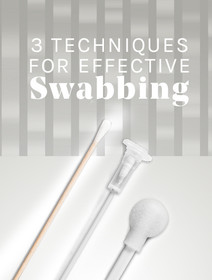Posted by QC on 20th Mar 2019
3 Steps for Effective Swabbing at a Crime Scene
DNA swabbing has revolutionized crime scene investigation. Now forensic professionals can extract information from even the tiniest of samples of epithelial cells, blood, semen, saliva, urine, bone, and other tissue.
But DNA testing for forensic analysis is only as effective as the sample collection methods. Improper sample collection, transport, and testing can lead to contaminated evidence and potentially invalidated results.
To ensure your forensic swabbing methods pass muster, we recommend you follow the steps outlined in each of these the three key stages of effective DNA swab sampling:
- Preparation
- Swabbing for cells
- Preservation of cells for transport
We cover best practices for each step in detail below, beginning with the preferred precautions and methods for forensic swabbing.
COLLECTION OF CELLS FOR ACCURATE DNA SWAB PROCESSING
1) PREPARATION
The first step to effective DNA swabbing is careful preparation. You must ensure that your crime scene techs are equipped with the right equipment to do their job well. To start, you should ensure all techs have the following:
APPROVED PERSONAL PROTECTIVE EQUIPMENT
Contamination of samples can become a huge issue in court—potentially compromising months or even years of detective work with a single stray hair or bead of sweat. That’s why well-fitting Personal Protective Equipment such as gloves, masks, overalls, shoe covers, and hair covers should be employed at all times during DNA swab collection.
EVIDENCE COLLECTION KITS
You should also have a few crime scene collection kits equipped with the necessary tools of your trade. Your kit should include everything from sterile swabs and distilled water or transport media to bindle paper, forceps, a camera, evidence tape, graph paper, and flashlights.
A full list of crime scene essentials, including a breakdown of the various types of evidence collection kits and their contents, is available here.
THE RIGHT TOOLS
When it’s time for your department to reorder your collection equipment, choose a product made especially for forensic sample collection, with particular capabilities for touch DNA, blood, DNA under fingernails, buccal cells, and more.
2) SWABBING FOR CELLS
According to a study released by the National Criminal Justice Reference Service, swabbing is the preferred sample collection method over taping for recovering DNA. Additionally, swabs do a better job of both collecting and releasing samples than tape, and are also preferable to cuttings as altering evidence in this way may compromise its integrity. Depending on the sample type (blood, saliva, touch DNA, etc.) the swabbing methods you employ may vary. Whatever swabbing methods you use, changing gloves and forceps after each item is the easiest way to avoid cross contamination.
Here are the three most popular techniques for swabbing:
SWABBING FOR TOUCH DNA
For a more comprehensive overview of how to swab for touch DNA, please see our earlier post.
- If using a dry swab, extract distilled water from vial using sterile pipette and apply one drop to the side of the tip. Do not use more than one drop, and do not dip the swab into water.
- Apply tip to sample area and rub using moderate pressure while rotating the swab by redepositing specimen. Do not rotate more than once.
- If using dry swab, allow to air dry then place tip in dry transport tube or vial.
DOUBLE SWAB TECHNIQUE FOR TOUCH DNA
A study conducted by The US National Library of Medicine found that the double swab technique improves the quality of DNA swab profiles.
- Moisten first swab with water, buffered saline, or lysis buffers; allowing dried samples to become rehydrated. Collect sample.
- Use dry swab to collect remainder of sample from same spot.
SWABBING BLOOD OR OTHER BODILY FLUIDS
The California Department of Justice lays out several considerations for swabbing blood and bodily fluids.
- Choose the right swab size: According the the CDOJ, “the size of the stain should influence the size of a substrate used to collect the stain… Do not smear a small stain over a large surface.” This can be achieved by using a small tipped swab or by concentrating the stain into just one small area of the swab.
- Slightly moisten swab tip with distilled water, following the steps outlined above.
- Apply tip to sample area and rub with moderate pressure, rotating only once.
- Allow to air dry.
3) PRESERVATION OF CELLS FOR SAFE TRANSPORT & STORAGE
The most important aspect of collecting cells is ensuring the swab is completely dry during transport to prevent mold and other bacterial growth.
Traditionally, swabs have been dried then transported in an envelope or drying box, but in recent years specially designed collection tubes have become increasingly popular for both their convenience and effectiveness in preserving samples.
BREATHABLE TRANSPORT TUBES FOR ADVANCED SAMPLE PRESERVATION
There are products on the market for DNA testing and forensic evidence collection packaged in reclosable dry transport devices. These products, patented by Puritan, include ID labels in every package.
There are two distinct transport tube types available: one is self-contained for safe transport and is designed to fit into traditional test tube racks effectively. This type of transport tube holds swabs up to six inches in length.
Another line of transport tube not only fits in traditional test tube racks, but also eliminates roll if laid on a flat surface or clinician's bench. These transport tubes hold swabs up to five inches in length.
Both tube designs are fitted with an air breathable Tyvek® filter that allows the swab to dry while maintaining the integrity of the sample during transport. You can learn more about these transport tubes here.
Article originates from Puritan "Three Key Steps to Effective DNA Swab Collection at Crime Scenes"


